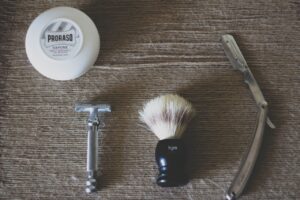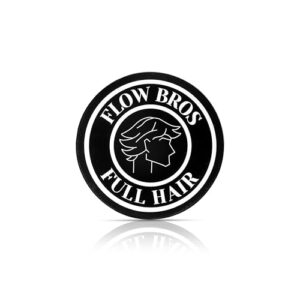Get a Barber-Quality Bald Fade at Home
Get a clean, professional-looking bald fade at home with a simple, safe six-step routine that saves money and boosts confidence; crazy fact: many barbers charge $40-plus, but you can master this—gently, step by step.
What You’ll Need
Beginner Bald Fade: Step-by-Step Guide to a Clean Fade
Step 1: Start with a Clean, Dry Canvas
Don’t skip this—dirty or damp hair hides mistakes and ruins blending. Simple prep = huge payoff.Wash and thoroughly dry your hair before clipping. Clean hair lets clippers move smoothly and prevents uneven cutting.
If your hair is product-heavy, shampoo and condition—rinse well. Towel-dry, then blow-dry on low to lay the hair flat. Comb hair into your natural part or the direction you’ll be cutting. For curly or very thick hair, detangle gently with a wide-tooth comb to stop tugging.
This prep step reduces tugging, prevents clogging the blades, and makes guard sizes behave predictably when you start your fade.
Step 2: Establish the Baseline and Guideline
Set one strong line now and everything else follows—think of it as the roadmap to symmetry.Decide where your fade will start — low (just above the ears), mid (around the temple), or high (near the crown). Use a longer guard (e.g., #3–#5) to cut an initial uniform length over the whole head so you can see the true shape.
Choose the guideline height — where the shortest, skin-level area will begin — and attach a mid-length guard (e.g., #1–#2). Run the clippers firmly around the head to create a defined line.
Work from the back and sides toward the front, checking symmetry with a hand mirror. Keep hands steady and use short, upward strokes.
Step 3: Create the Fade Gradient
Want a seamless blur from skin to hair? Master the flick-out and guard graduation trick.Progressively switch to shorter guards as you move down from the guideline toward the nape and around the ears. Use overlapping upward passes and a light flicking motion at the end of each stroke to soften harsh lines.
Work in short sections and repeat until transitions look even. For example, move from a #2 to a #1, then to a clipper-over-comb or no guard at the very bottom.
Work symmetrically on both sides, check angles with a handheld mirror, pause frequently, step back, and view under different lights — fading is about subtle adjustments, not brute force cutting.
Step 4: Blend the Midsection Like a Pro
This is where most amateurs fail—smart blending makes the fade look intentional, not hacked.Refine transitions using intermediate guards and the clipper-over-comb method. Comb the hair up from the head and drag the appropriate guard just over the comb teeth to remove bulk without creating lines.
Work slowly around the crown and temples where hair direction changes. Tilt the comb and clipper slightly to follow growth patterns and avoid creating a visible band.
Use the half-guard technique for stubborn bands: move the clipper at a slight tilt or open the clipper lever to micro-adjust length. Snip small sections with scissors where clipper action leaves awkward patches — blend those scissor-touched spots with a light comb-over cut.
Regularly re-check both sides to maintain a consistent slope.
Step 5: Clean the Edges and Define the Shape
Sharp lines sell the cut—edgework transforms a good fade into a polished one.Switch to a detail trimmer and tidy the hairline, around the ears, and the nape. Decide on a natural contour or a pronounced outline and trace with short, controlled strokes. Use a straight razor or razor‑edged trimmer for a true bald finish at the very bottom; apply a little shaving cream before using a razor. Pay attention to sideburn symmetry—measure one point and match it—and mirror the temple angle (sharper for square faces, softer for round faces). Step back and check.
Finish by wiping away loose hair, checking the edges in multiple mirrors, and softening any overly crisp lines with a light pass of the clippers or a blending brush.
Step 6: Final Check, Clean-Up, and Aftercare
Your final 10 minutes determine longevity—protect the cut and your scalp for lasting crispness.Inspect the entire head under bright light and fix tiny inconsistencies with targeted trims. If you see a thin line at the nape or a harsh step near the temple, clip a hair or two and recheck.
Vacuum or brush away stray hairs, then wash off trimmings in the shower to avoid itch.
Apply a light moisturizer or post‑shave balm to soothe the skin, especially where you used no guard — for example, use an aloe or witch‑hazel balm if you feel redness.
Schedule touch‑ups every 1–2 weeks depending on your hair growth.
Take before‑and‑after photos to track progress and refine your technique next time.
You’ve Got This
A clean bald fade at home is achievable with preparation, patience, and practice; follow these six steps, take your time, and you’ll consistently get sharper results—keep tools maintained and tweak the routine as your skills improve. Ready to try today?













Tried this guide last weekend and honestly — not bad! The baseline step (Step 2) was the trickiest for me, took a few tries to get the guideline even. Pro tip: use a small mirror behind you to check symmetry.
Question for others: how do you keep the clippers from snagging when blending the midsection? My clipper kept pulling a few hairs.
I’ve had that too. Changing to a fresh, sharp blade made a huge difference for me. Also oil the blades before starting.
Also check the clipper guards — sometimes a worn guard makes it catch. And shave with the grain when you do the bald parts, then against if needed for extra smoothness.
Nice one, Jessica — glad it helped! For snagging, try loosening the blade slightly and use shorter, lighter strokes. Also make sure the hair is fully dry and use a light brush-off between passes.
Nice guide but wish there were more photos of the guide lines at different head shapes. My skull isn’t perfectly round and following the baseline felt weird.
Anyone with a different head shape adapt the steps?
Good point, Derek. Heads do vary a lot. If the baseline feels off, start by mapping the guideline where the hair naturally changes length — follow the bone line where possible. You can also make smaller, staggered guidelines instead of one continuous line.
I have an odd-shaped head too. I mark multiple small guidelines around the head instead of one big one — makes blending simpler.
This guide is great for beginners. Step-by-step is clear and not intimidating. I will say: invest in a decent set of guards and a good trimmer — saved me tons of time.
Also, for anyone nervous about Step 6: Final check — ask a friend to give quick feedback before you call it done. Fresh eyes spot asymmetry fast.
My roommate does the final check for me. He doesn’t even have to say anything — just hands me the mirror lol
Absolutely — a second pair of eyes can catch things you miss. Thanks for the recommendation on the tools too.
Echoing the tools note: cheap clippers make blending way harder. Spend a bit, it’s worth it.
Short and sweet: this guide made my DIY fade manageable. Step 1 about starting with a clean, dry canvas is underrated — washed, dried, and combed properly made blending so much easier.
Had to remind myself of that too. Skipped a shower once and it was a disaster 😂
Exactly — prepping the canvas is half the job. Dirty or damp hair behaves very differently when cutting.
Quick question: for Step 3, when creating the fade gradient, should I move the clipper up-and-down or side-to-side? My fades always either look too choppy or too blended (i.e., no contrast).
Great question. Small up-and-down scooping motions while angling the clipper slightly will give a smoother gradient. Use side-to-side for quick bulk removal, but the blend comes from those short vertical passes at varying lengths.
Straight to the point: Step 5 saved my hairline. I’m terrible at edges but the guide’s edging tips are solid. Only downside: my neck looked patchy at the very end — any tips for cleaning that up without going too short?
Love the humor in this guide. The ‘You’ve Got This’ bit actually motivated me to stop overthinking and just do it. Results were surprisingly decent!
Couple of practical notes:
– When in doubt, go a touch longer and then refine.
– If you’re doing the bald part yourself, tilt your head forward to get a flatter surface.
Also, gonna be honest — I messed up my left ear line and had to even it out by trimming more on the other side. Crying into my coffee afterward but hey, still wearable 😂
Coffee stains aside, sounds like you recovered pretty well. Left vs right is always the drama.
Glad it gave you a confidence boost, Zoe! Your last line made me laugh. Live and learn — symmetry is hard but doable.
Hah, coffee & hair fixes. Solid combo.
Same here — my left ear always betrays me. Practice makes less crying, I promise.
Okay real talk — I followed this and my fade still looked slightly boxy on one side. I re-read Step 4 about blending the midsection and did slow passes with my trimmer at different angles. Fixed it mostly.
This is kind of a long post bc I want to be helpful:
1) Use a comb to lift the hair and check where the hard lines are.
2) Flip your head often — what looks fine from one angle can be obvious from another.
3) For edges, use a small trimmer for detail, then go over with a single-blade razor for crispness.
Also, shoutout to the guide for the “final check” checklist — seriously clutch. 🙌
Flipping the head is KEY. I tape a disposable mirror to the wall so I can see the back while using the handheld one.
Boxy fade here too. Took me three passes to get it right. Patience is everything.
Sometimes a stray hair from the ear area throws off the whole silhouette. Trim those carefully.
Also check your posture — leaning weird can make one side look different when you finish.
Thanks, Hannah — that’s the type of detailed feedback others will love. Flipping the head and using different angles is a pro technique we’ve seen work well.
Wow, this was detailed — loved the fade gradient walkthrough. I’m not a pro but followed these steps and ended up with a pretty decent fade.
Couple of notes from my experiment:
– Use a handheld vacuum or the trimmer’s dust brush to keep the clipper area clean while you work.
– When you blend, think of small “scooping” motions rather than flat passes.
Huge thanks to the author! 😄
One more: if you mess up a section, don’t panic. Go a bit shorter and re-blend. It’s easier to correct a too-long area by taking more off than to regrow hair 😉
Agreed. Also, try stretching the skin slightly where you’re blending; it helps the clipper lay flatter and blend more smoothly.
Thanks Maya! Love the scoop analogy — that’s exactly what we mean by blending like a pro. Vacuum trick is underrated too.
Haha re-grow is the ultimate fixer-upper. Good tips all around!
Scoop motions for the win. I also tilt the head slightly to see the line better — helps when the light in my bathroom is bad.
Tried it once with clippers only and it was meh. Went back and used a razor for the very bottom bald part in Step 3 and Step 5 — way cleaner finish. Just be careful around the ears.
Small rant: why do mirrors always lie about how even your fade is? 😅
Razor for the final bald part is a good move if you’re comfortable with it. Take it slow near the ears and use short strokes.
Thanks for the detailed guide. A few things I’d add from my attempts:
1) Use clippers with variable guards for smoother gradations.
2) When creating the baseline, don’t set it too low on the first pass — you can always go lower.
3) Aftercare: apply a light antiseptic and moisturizer if you shaved any skin.
Also, the aftercare section should maybe mention sun protection for the freshly trimmed scalp — burned scalps are no joke!
Second the sunscreen tip. I learned the hard way after my summer fade 😂
Great additions, Priya. Sunscreen for the scalp is an excellent callout — we’ll add that in the next update.
Ooh I forgot sunscreen — thanks. My scalp got a little red once too.
Nice checklist. I’ll add: cold water rinse after any nick helps reduce irritation.
Followed Step 1–4 perfectly and still ended with a lopsided look. Feeling a bit defeated ngl. Maybe I need to practice more or my hands are just shaky.
Anyone else had that and then suddenly nailed it later? How long did practice take you?